 Facebook
Facebook
 X
X
 Instagram
Instagram
 TikTok
TikTok
 Youtube
Youtube
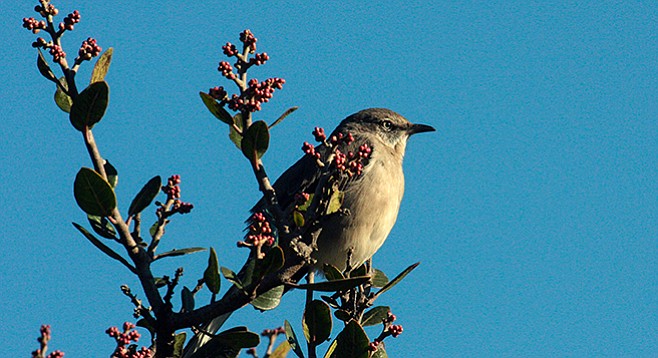

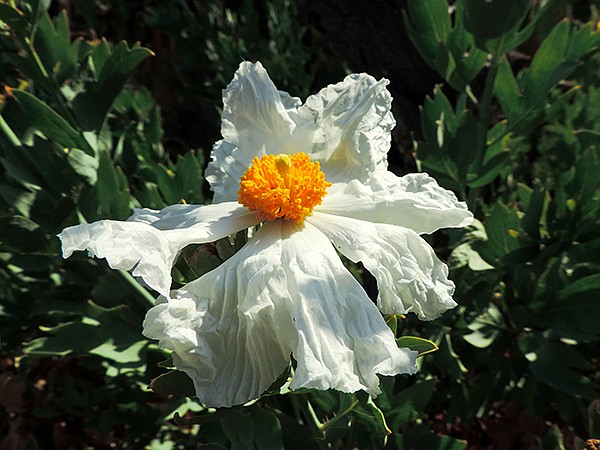
When thinking of Balboa Park, images of the San Diego Zoo, museums, theaters, and acres of gardens with lush exotic vegetation come to mind. Relatively few are aware of the eastern portion of the park consisting of Morley Field, with its 25 tennis courts, the Balboa Park Golf Course, several multi-purpose fields, a disc-golf course, a velodrome, a parcourse, plus acres of open space that hints of the park’s original landscape. One only needs to walk a short distance to discover the relatively untouched expanse of Florida Canyon. The 150 acres of coastal sage scrub provide an important habitat for wildlife. Here is found many native chaparral plants and animals, plus miles of interconnected trails that may be used for walking, jogging, and bicycling, all within easy reach of a major metropolitan area.
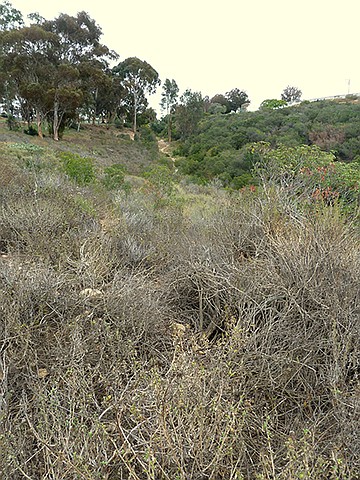
The hiking trails traverse the east and west sides of Florida Canyon and are bisected at the bottom of the canyon by Florida Drive. There are several entrances from which the Florida Canyon trail complex can be entered, but the most frequently used and conveniently located starting point is a 40-vehicle parking area just west of the tennis courts off of Morley Field Drive. From this trailhead, nature lovers may choose to initially take a short loop walk through the California Native Plant Garden, comprised of native San Diego plants, some with identification tags to acquaint visitors and help them to identify the flora that may be found along the trail.
From here there are three starting points to enter the trail complex. Due south across a grassy field used as a dog run begins a gradually descending path that soon divides into several optional routes allowing either an in-and-out approach or a loop hike. Visitors may instead decide to start their hike by heading southeast of the parking lot through a towering eucalyptus grove and then turn due south past a velodrome and along the eastern rim of Florida Canyon. This route is a combination of graded dirt roads and foot paths that are connected at points to the trail complex below in the canyon bottom. Finally, visitors also have the option to head west down Morley Drive, across Florida Drive at a four-way stop, proceed to a small grove of redwoods that were planted in the area, and then turn south on a trail that parallels the roadway and allows the quick-footed to cross the street further south (without the assistance of crosswalks or stop signs), to make their way back on the trail complex on the east side of the canyon.
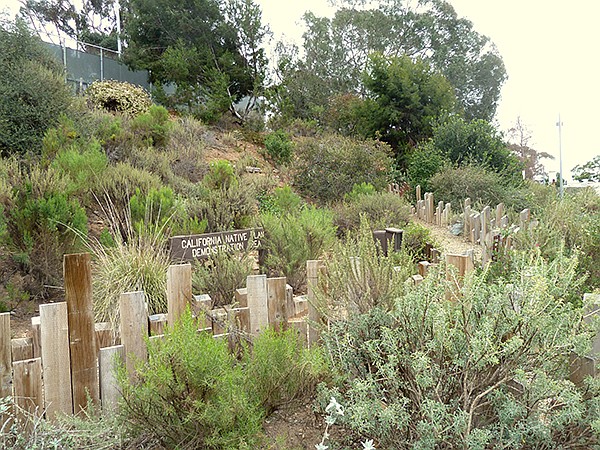
Among the native plants to be discovered along the trails are laurel sumac, black sage, scrub oak, deerweed, broom baccharis, Mohave yucca, Mexican elderberry, and matilija poppy, which is also known as the fried-egg plant because of its distinct yellow “yolk” center and surrounding large white petals. Birds that are frequently seen are black phoebes, red-tailed hawks, spotted towhees, hummingbirds, bush tits, and wrentits that are often called the “voice of the chaparral” for their distinctive dropped ping pong ball song. Keep an eye out for coyote scat left in the middle of the trail. You can often tell what the coyote had for dinner from the presence of rabbit fur and seeds. If your wanderings take you down to the canyon floor, you’ll discover many riparian (riverbank) plants by the small streambed. Look for western fence lizards, argiope spiders with colored abdomens, spotted and striped harlequin bugs, and cochineal scale insects with their red stain. Also look for ground squirrels and cottontails. Some of the non-native plants that will be encountered are the eucalyptus and various palm species.
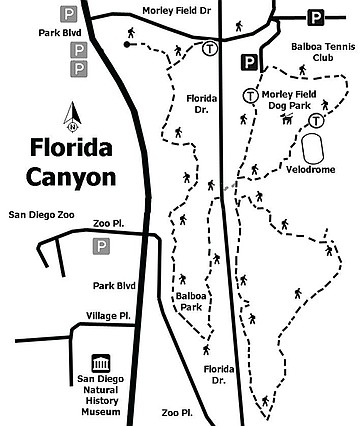
It was during the summer of 1973 that Helen Witham Chamlee, Nancy Inman, and Betty Robinson began the FIorida Canyoneers by training 27 volunteers, associated with the nearby San Diego Natural History Museum, in the plants, animals, geology, history, and Native American uses of the canyon area. In November of that year, the Florida Canyon Nature Trails formally opened and some 5000 people participated in the hiking program led by the trained trail guides. When a series of fires greatly diminished the dense and diverse chaparral brush and other flora found there, the volunteers decided to find other areas in which to guide and renamed themselves simply the Canyoneers. Today the Museum Canyoneers lead weekly hikes throughout San Diego County from the coast to the deserts, providing the public with opportunities to visit some 70 different trails every year. For information on how to participate in these free outings, visit sdnat.org/canyoneers.
While Florida Canyon may not appear as it did some 40 years ago, more than 200 plants have been identified in the canyon at different times of the year. The other inhabitants of this diverse floral community reflect a corresponding biodiversity with the many species of birds, reptiles, insects, and mammals.
Be certain to take adequate water and sun protection since there is little shade along the trails.
Distance from downtown San Diego: 2 miles. Allow 5 minutes driving time (San Diego). From Park Blvd., turn east on Morley Field Dr., crossing Florida Dr., and continue uphill until taking the first right and then an immediate right (south). Park in the California Native Plant Garden lot.
Hiking length: From 1 to 5 miles.
Difficulty: Easy to moderate with elevation gain/loss ranging from 200–800 feet, depending on routes selected. Hikers, bicycles, and dogs (on leashes) are allowed. Facilities and water at Morley Field. Hours: 24 hours, but best visited before dark.




When thinking of Balboa Park, images of the San Diego Zoo, museums, theaters, and acres of gardens with lush exotic vegetation come to mind. Relatively few are aware of the eastern portion of the park consisting of Morley Field, with its 25 tennis courts, the Balboa Park Golf Course, several multi-purpose fields, a disc-golf course, a velodrome, a parcourse, plus acres of open space that hints of the park’s original landscape. One only needs to walk a short distance to discover the relatively untouched expanse of Florida Canyon. The 150 acres of coastal sage scrub provide an important habitat for wildlife. Here is found many native chaparral plants and animals, plus miles of interconnected trails that may be used for walking, jogging, and bicycling, all within easy reach of a major metropolitan area.

The hiking trails traverse the east and west sides of Florida Canyon and are bisected at the bottom of the canyon by Florida Drive. There are several entrances from which the Florida Canyon trail complex can be entered, but the most frequently used and conveniently located starting point is a 40-vehicle parking area just west of the tennis courts off of Morley Field Drive. From this trailhead, nature lovers may choose to initially take a short loop walk through the California Native Plant Garden, comprised of native San Diego plants, some with identification tags to acquaint visitors and help them to identify the flora that may be found along the trail.
From here there are three starting points to enter the trail complex. Due south across a grassy field used as a dog run begins a gradually descending path that soon divides into several optional routes allowing either an in-and-out approach or a loop hike. Visitors may instead decide to start their hike by heading southeast of the parking lot through a towering eucalyptus grove and then turn due south past a velodrome and along the eastern rim of Florida Canyon. This route is a combination of graded dirt roads and foot paths that are connected at points to the trail complex below in the canyon bottom. Finally, visitors also have the option to head west down Morley Drive, across Florida Drive at a four-way stop, proceed to a small grove of redwoods that were planted in the area, and then turn south on a trail that parallels the roadway and allows the quick-footed to cross the street further south (without the assistance of crosswalks or stop signs), to make their way back on the trail complex on the east side of the canyon.

Among the native plants to be discovered along the trails are laurel sumac, black sage, scrub oak, deerweed, broom baccharis, Mohave yucca, Mexican elderberry, and matilija poppy, which is also known as the fried-egg plant because of its distinct yellow “yolk” center and surrounding large white petals. Birds that are frequently seen are black phoebes, red-tailed hawks, spotted towhees, hummingbirds, bush tits, and wrentits that are often called the “voice of the chaparral” for their distinctive dropped ping pong ball song. Keep an eye out for coyote scat left in the middle of the trail. You can often tell what the coyote had for dinner from the presence of rabbit fur and seeds. If your wanderings take you down to the canyon floor, you’ll discover many riparian (riverbank) plants by the small streambed. Look for western fence lizards, argiope spiders with colored abdomens, spotted and striped harlequin bugs, and cochineal scale insects with their red stain. Also look for ground squirrels and cottontails. Some of the non-native plants that will be encountered are the eucalyptus and various palm species.

It was during the summer of 1973 that Helen Witham Chamlee, Nancy Inman, and Betty Robinson began the FIorida Canyoneers by training 27 volunteers, associated with the nearby San Diego Natural History Museum, in the plants, animals, geology, history, and Native American uses of the canyon area. In November of that year, the Florida Canyon Nature Trails formally opened and some 5000 people participated in the hiking program led by the trained trail guides. When a series of fires greatly diminished the dense and diverse chaparral brush and other flora found there, the volunteers decided to find other areas in which to guide and renamed themselves simply the Canyoneers. Today the Museum Canyoneers lead weekly hikes throughout San Diego County from the coast to the deserts, providing the public with opportunities to visit some 70 different trails every year. For information on how to participate in these free outings, visit sdnat.org/canyoneers.
While Florida Canyon may not appear as it did some 40 years ago, more than 200 plants have been identified in the canyon at different times of the year. The other inhabitants of this diverse floral community reflect a corresponding biodiversity with the many species of birds, reptiles, insects, and mammals.
Be certain to take adequate water and sun protection since there is little shade along the trails.
Distance from downtown San Diego: 2 miles. Allow 5 minutes driving time (San Diego). From Park Blvd., turn east on Morley Field Dr., crossing Florida Dr., and continue uphill until taking the first right and then an immediate right (south). Park in the California Native Plant Garden lot.
Hiking length: From 1 to 5 miles.
Difficulty: Easy to moderate with elevation gain/loss ranging from 200–800 feet, depending on routes selected. Hikers, bicycles, and dogs (on leashes) are allowed. Facilities and water at Morley Field. Hours: 24 hours, but best visited before dark.